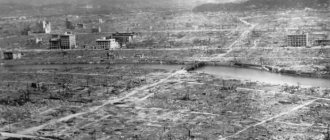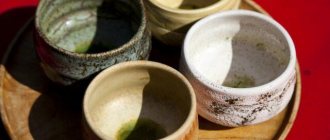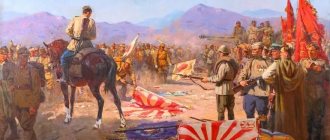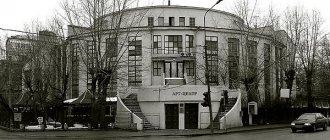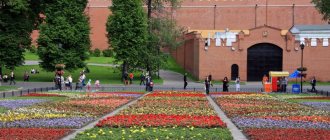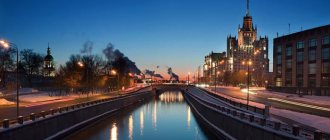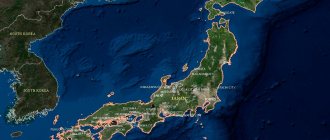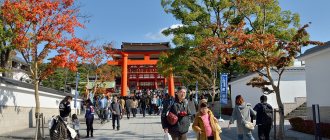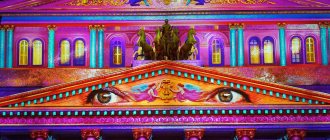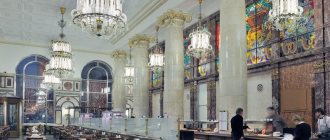Arriving in Hiroshima, probably every modern tourist thinks that he will find here a dilapidated city with “dead” neighborhoods, empty houses that were hastily abandoned by their residents during the bombing. But as soon as the visitor enters the city, his opinion changes radically, because he is greeted by a modern-looking city with developed infrastructure and high-rise buildings. And, what’s most surprising, there is active life everywhere. However, the tragedy in Hiroshima in August 1945 left its mark in the memory and hearts of the Japanese. For themselves and for the world, they created a unique material reminder of those times - the Hiroshima Peace Museum.
Peace Memorial in Hiroshima. Memory of a distant explosion
Post-war Japan is famous for its largest public ensemble, which was designed and built by one of the most famous architects of the twentieth century, Kenzo Tange, the Peace Memorial in Hiroshima (Japan). This complex is an organic fusion of national ideas and modern plastic art in space.
Peace Park (or Hiroshima Peace Memorial) is one of the major must-see attractions in Hiroshima. Its study is even included in the curriculum of Japanese schoolchildren. In this article we will introduce the reader in more detail to the monuments of this memorial complex.
Other monuments of the complex
The Hiroshima Peace Memorial Complex has other monuments. All together there are approximately 50 of them. The most famous among them are the following monuments:
- The atomic tree is a firmian tree. The plant was transplanted to the park in 1973. Previously, it grew at a distance of 1.3 kilometers from the epicenter of the explosion. As a result of irradiation, the greenery dried out, but the next year it bloomed again. And thus instilled hope in those who managed to survive the atomic attack.
- Monument to the poet Toge Sankichi. This is a local author who has published a huge number of works calling for peace and the abandonment of atomic weapons.
The Peace Memorial Complex also has many other statues that constantly remind us of the days of the terrible tragedy.
Where is the Peace Memorial located, and what objects does it include?
In the center of the city on an island in the Ota River, on a territory completely destroyed by the explosion of an atomic bomb in the Hiroshima Nikajima region, which for four centuries was the most developed commercial center, and since the 19th century also an administrative center. In 1945, 6.5 thousand residents lived in Nikajima alone, several schools, many shops, several hospitals and other institutions operated.
The architectural ensemble of Peace Park is located on more than 12 hectares. The grounds of the memorial complex contrast sharply with the modern appearance of Hiroshima, with a typical cityscape filled with shops, storefronts and advertising lights. Before the war, this central area was the busiest in the city.
The Hiroshima Peace Memorial Park was founded ten years after the atomic explosions in Hiroshima and Nagasaki. Japanese architectural guru Kenzo Tange, as part of a group with several other architects, designed the future Memorial, including the only remains of the Hiroshima Prefectural Industrial Promotion Hall exhibition building that remained at the very center of the explosion.
The reinforced concrete walls of the building and the half-destroyed dome to this day serve as a reminder of that day of hell on earth, when the entire city choked in the fire of an atomic explosion. The Peace Dome is the main symbol of an atomic explosion. An eternal reminder of that dark day in Japanese history is the entire Hiroshima Peace Memorial. The Genbaku Dome is its key figure, although it is located on the other side of the river. It is visible from anywhere in the Park.
The main components of the park can also be called the Hiroshima Peace Memorial Museum, a large ritual bell, the Sadako monument in Hiroshima and the cenotaph - a symbolic tombstone of enormous size, which was erected in memory of the inhabitants of Hiroshima and Nagasaki who died from the atomic explosions. The composition also includes many monuments and the Flame of Peace monument.
The most famous monument on the territory of the memorial, which you cannot pass by without crying, is the monument to Sadako Sasaki in Hiroshima, a twelve-year-old Japanese girl. She was one of the many victims of the atomic bomb. Her name has already become a household name and represents all the children who died from a nuclear explosion.
Peace Park
The Peace Memorial Park in Hiroshima is considered a holy place for the townspeople and the entire Japanese people. Peace Park serves as a reminder and evidence of the horror of the consequences of the use of atomic weapons against civilians. Peace Park is located on an island surrounded by a river. On August 6, 1945, at 8.15 am, this place turned into hell, as it fell into the epicenter of an atomic bomb explosion. Everything in the area was destroyed, and people instantly burned to death.
The park was opened in April 1954. Today, Peace Park is visited by millions of people; every stone, obelisk or monument contains the history of distant tragic days. The purpose of the Peace Park is to reach the hearts of everyone living on earth and so that humanity renounces the use of nuclear weapons.
The Hiroshima Peace Memorial Park is located on an area of 122,100 square meters in the urban district of Nakajima, the area that became the epicenter of the atomic bomb explosion on August 6, 1945. This area has always been prosperous, in the Edo era (1603-1868) Nakajima was a famous trading center, since the 19th century, in the Meiji era (1868-1912) this area was the political, administrative and commercial center of Hiroshima, in the Showa era also was the center of trade, there were many shops, cinemas, clinics, pharmacies and institutions. The buildings were built densely and were in close proximity to each other. The residents of this area alone numbered 6,500 people, and on August 6, 1945, many students and the Volunteer Army Corps were in this area dismantling abandoned buildings. And in an instant everything was leveled to the ground...
On the anniversary of the atomic explosion on August 6, 1949, a law was passed to restore the city of Hiroshima and declare it a city of peace. At the same time, it was decided that the territory of the Nakajima district would become the Peace Memorial Park. The author of the project is the Japanese architect Kenzo Tange (1913-2005).
The park contains the Memorial Museum, many monuments, a ritual bell and a cenotaph - a collective tombstone for those killed by the atomic bombing. In total, on the territory of the Peace Park there are 57 objects associated with the tragic events of the summer of 1945.
The elementary school , built in 1928, was located 410 meters from the epicenter of the atomic explosion. The school building suffered significant damage, almost everything was burned out. At the time of the explosion, there were 10 teachers and 400 students in the first and second grades at the school; everyone died except for one student and one teacher, who miraculously survived. Despite the explosion, the walls of the school were not destroyed, and almost from the next day after the explosion, a first aid station was located on its territory, where numerous wounded were admitted. A large number of those killed in the explosion were cremated on the school grounds. In subsequent years, the school was repaired and restored, and in 1988 a peace museum was opened at the school.
Monument to the Volunteer Army Corps - On August 6, 1945, 250 members of the Volunteer Army Corps from the village of Kawauchi were working to clear up the destruction in the immediate vicinity of the Nakajima area, i.e. almost at the epicenter of the explosion. All volunteers died, leaving their families without breadwinners. In 1964, the residents of Kawauchi erected a monument to their fellow countrymen. The monument is made of natural stone, on it are engraved the names of all those who died from the Volunteer Army Corps and an epitaph that one cannot forget the horrors that the explosion of the atomic bomb brought.
Second Secondary School - this memorial is dedicated to those killed on August 6, 1945. 352 students and teachers who were practically burned to death during the explosion, so many could not be identified.
Also on the territory of the Peace Park, a memorial was erected dedicated to the dead students and teachers of the municipal shipbuilding industrial school, who also worked on clearing the city - the epitaph on the granite monument reads: “it was really a lightning strike out of the blue when on August 6, 1945 at 8.15 our dear the city of Hiroshima turned into hell on earth...” The school was located 500 meters from the epicenter of the explosion and only one student, who felt unwell and went to the hospital, remained alive, the remaining 270 people died, it was impossible to identify anything.
Ayoi Bridge - This T-shaped bridge became a target for American bombers. It was its unusual shape, clearly visible from a height, that was the target on August 6, 1945, but something prevented the atomic bomb from being dropped on target and it exploded in the air above a hospital located three hundred meters from the Ayoi Bridge. The bridge was built in 1932, its original width was 15 meters. During the bombing, the bridge was partially destroyed, after the war it was reconstructed, but the condition of the bridge was poor and in 1983, a new one was built on the site of the old bridge, 123.4 meters long and 40 meters wide with six-lane traffic, tram tracks and pedestrian paths. As a reminder of the atomic bombing, you can still see old deformed pillars at the foot of the bridge today.
from the site https://www.geocities.jp/s20hibaku/photo/koe_291.html
On the territory of the Peace Park there is an earthen burial mound of an atomic bomb ; at this place there were a great many dead people; corpses from nearby areas and those caught from the river were brought here for cremation. This mound contains the ashes of approximately 70,000 victims. These were the remains of persons whose ashes were not claimed because they died in families or those who could not be identified. Every year the names of victims who have been identified are published in the hope that relatives will come forward to claim their ashes. Of the 2,432 individual containers stored in the mound, 824 remain unclaimed to this day.
A temporary mound was built in 1946 at the expense of the townspeople; in 1955, the municipality of the city of Hiroshima built a solid mound and the ashes of all the victims stored in other areas of the city were transported here. The diameter of the mound is 16 meters, height 3.5 meters.
The Peace Bell was opened on September 20, 1964 and represents the desire of the residents of the city of Hiroshima for a peaceful existence without wars and nuclear weapons, so that the bell rings in every corner of the vast earth and so that it can reach the heart of every person. The Peace Bell is designed as a dome roof representing the universe, which is supported by four pillars. Around the bell there is a pond 2 meters wide and 80 centimeters deep. Lotuses are planted in the pond, which bloom every year on Memorial Day, August 6th. Lotus leaves were used in August 1945 to reduce the suffering of burn victims.
There are many fountains located on the territory of the Peace Park. Water plays a big role in this memorial site; you can see water bottles left behind at many monuments. The burned people after the atomic explosion were thirsty and asked for water, but could not get it.
Flame of Peace - this monument represents two palms facing the sky. Expresses condolences to the victims of the atomic bombing. The fire was lit on August 1, 1964 and will burn until nuclear weapons disappear from the face of the earth. The Flame of Peace is used in various social movements for peace; also in 1994, the flame of the Asian Games, which took place in Hiroshima, was lit from the Flame of Peace monument.
Memorial Cenotaph - The cenotaph is a symbolic grave, a monument to the numerous victims of the atomic bomb explosion on August 6, 1945. The cenotaph was one of the first memorial monuments to be built on an open field on 6 August 1952. The epitaph for the monument says that evil must not be repeated.
The cenotaph is an ancient arch that is a refuge for lost souls, the author of this project is Kenzo Tange. The stone inside the monument contains a list of the names of those killed and those who died as a result of the atomic explosion, regardless of nationality. Names are added to this list if identified. To date, the list contains 286,818 names and a large number of unidentified victims.
The cenotaph is surrounded by the Peace Pond, which is 17 meters wide and 70 meters long and in the distance is the Flame of Peace memorial. The water in the pond has symbolic meaning.
The monument dedicated to the Japanese girl Sadako Sasaki deserves special attention.
Fountain of Prayer - This memorial was built in memory of the people who died after the atomic bomb exploded and were thirsty and never received this water. The scale of the tragedy was so great that the injured people lay on the streets and no one could help them. Even those who were able to get to the hospital could not get the necessary help. There were so many victims, but there were practically no medical personnel and hospitals. Hospitals and clinics in Hiroshima were concentrated in the city center, where the main blow fell and, accordingly, many of the medical personnel died in the explosion.
The Fountain of Prayer was built with money from the Hiroshima Bank and commercial entities, and its construction was completed in November 1964. The fountain is one of the best fountains in Japan. The size of the fountain is 27 meters by 19 meters; every minute 11 tons of water are thrown up to a height of 10 meters. At night, the fountain is illuminated by 153 underwater lamps in red, blue, green, yellow and milky white.
The Story of Sadako Sasaki
Over time, the story of this real child became overgrown with all sorts of speculation and embellishments. But, nevertheless, the fact is the following. On August 6, 1945, like many other children in Hiroshima, Sadako, who was only two years old at that time, was playing with toys at home. When a uranium bomb exploded one and a half kilometers from the house, the child was thrown out of the window by the blast wave.
Miraculously, Sadako was able to survive. But soon she was diagnosed with leukemia. Huge tumors appeared on the neck and behind the ears. Doctors did not guarantee her even six months of life. But the little girl fought for another ten years.
One day, one of her friends, perhaps a fellow child who suffered from an explosion and was being treated for leukemia, told Sadako a legend. It said that whoever folds a thousand origami cranes out of paper will receive the fulfillment of his most cherished desire. The girl wanted to live more than anything in the world, because she was still so young. She began to fold origami paper figures from every piece of paper that fell into her hands.
It is believed that she had very little left to fold. But she died. Then her friends made a lot of paper cranes and brought them to her grave. The girl was buried with all the figures she had made. Since then, the tradition of folding paper cranes with wishes for a peaceful life has been firmly established in Japan for 70 years. Children and adults fold up the figures and leave them at the monument to the brave girl who loved life most of all.
Children's monument
The Hiroshima Peace Memorial (Genbaku Dome) also has a structure dedicated to deceased children. It is also called the “Sadako Monument” and the “Tomb of a Thousand Cranes”. Schoolchildren who often come here on excursions always hold garlands made of paper birds in their hands. This tradition has its own sad history.
Sasaki Sadako survived the bombing when she was only two years old. And in 1955 she was diagnosed with leukemia. The little girl believed that if she folded a thousand paper cranes, she would definitely get better. Sasaki created more than 1,300 birds from various wrappers. But in the end, after eight months of fighting the disease, she still died. Classmates who took Sasaki's death seriously decided to create a monument. It was dedicated to all the children who died as a result of the atomic bombing. The memorial was opened in May 1958.
Monument to white cranes in Hiroshima
With money raised by schoolchildren from all over Japan, as well as donations from Nobel Prize winner in physics Hideki Yukawa, a monument to white cranes was erected in Hiroshima. On a bronze pedestal there is a figure of a girl with a symbolic crane, which she releases into the sky.
Under the pedestal there is a bell that can make a sound not only from a blow, but also from a strong gust of wind. At the base of the monument is a black slab with the words carved: “This is our cry. This is our prayer. For the sake of world peace."
The Peace Park Museum has an entire exhibition dedicated to the teenage girl Sadako Sasaki, who died from the consequences of a nuclear explosion. The name of this child became a symbol of opposition to war using atomic weapons. The monument to the Japanese girl Sadako Sasaki in Hiroshima is also called the Children's Peace Monument (Hiroshima). There are monuments in her honor in Santa Fe and Seattle. All of them are designed to remind people of the horrors of war and prevent the new use of atomic weapons.
On the half-century anniversary of the atomic tragedy in Hiroshima, the Sadako Peace Garden was opened in Santa Barbara, California, USA, in memory of all the children of Japan who died during the atomic bomb explosions. In 2002, this Garden became part of the internationally recognized network of Peace Gardens. Large granite stones with images of cranes carved on them were placed in the center of the Garden.
Memorial Cathedral for World Peace
One of the largest Catholic churches in Asia, the huge gray World Peace Memorial Cathedral was built in 1954 at the initiative of a Jesuit priest named Hugo Lassalle, who survived the explosion of the atomic bomb. Designed by leading Japanese Murano architect Tongo, the building was built largely through contributions from many countries and people around the world. The main attractions of the cathedral are the four bells in the 46-meter tower, a magnificent organ from Cologne, bronze doors from Dusseldorf and an altar from Belgium.

